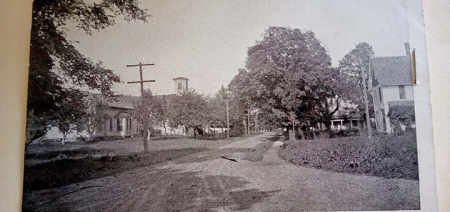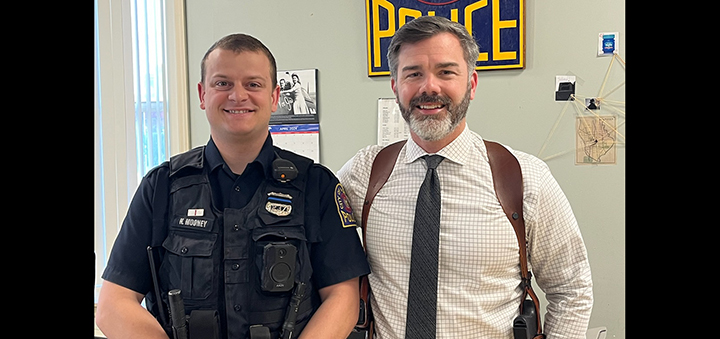Chenango In The Civil War: The Great Escape Of Lieutenant Dennis Thompson
Published:
September 25th, 2012

Editor’s Note: In conjunction with the Chenango County Civil War Commemoration Project Team, The Evening Sun will present a monthly series chronicling items of local interest during the war between the states, compiled and written by a number of local history enthusiasts.
By Sharon Donahe
Correspondent
Many amazing stories of survival despite incredible odds came out of the Civil War. Such is the story of an episode in the military career of Lieutenant Dennis Thompson.
The Thompson family resided in Otselic, Chenango County, New York where Dennis Thompson was born in August 1840. Thompson was hard working and intelligent. He received his education in the district school, followed by a course of study at the New York Central College at McGrawville and later Cazenovia Seminary. He would attend school in the summer and teach during the winter months in addition to working on the family farm. But then life was disrupted by the outbreak of the Civil War in the Fall of 1861. When the call went out for volunteers, Dennis Thompson enlisted in August 1862 in Company I of the 114th Regiment New York Infantry. He had just turned 22 years of age. He eventually achieved the rank of 1st lieutenant, and for a significant portion of his service was attached to the Ambulance Corps of the First Division.
In October 1864, Lieut. Dennis Thompson was in command of a subdivision of the ambulance train of the 19th Army Corps which was encamped at Cedar Creek, Virginia. Before daylight on October 19, Confederate troops initiated a well-executed surprise attack on the encamped Union troops. Thompson, awakened by the sounds of artillery, immediately began preparations for a rapid withdrawal of the ambulance train. The fields through which they retreated had many ditches and other obstructions, and in the haste of attempting to cross the fields, many of the ambulance train’s vehicles overturned and were wrecked. When his unit came to a halt for the purpose of determining which line of retreat offered the best chance of safety, he obtained permission to go back over the direction from which they had come to see if there was anyone in need of aid. No danger was anticipated. However, it was during this search that he was captured by the Confederates and taken to the rendezvous where some 1500 captured Union troops were being gathered.
In the beginning of the Battle of Cedar Creek, it appeared that the Confederates would be victorious. But then the Union troops rallied and mounted a counterattack that ultimately turned probable defeat into a Northern victory. When the Confederate guards realized the turn of events, orders were given to move out. The prisoners were admonished that any man who attempted escape would be shot, and the Confederate guards remained vigilant to prevent escape. By this time, the sun had set, making it very difficult to see. Thompson, fearing incarceration in a Confederate prison, determined that he would escape at the first opportunity no matter what the risk. The prisoners were on foot following the Confederate supply wagons. At the rear of the last wagon was a group of unarmed Confederate stragglers who were paying no particular attention to the prisoners. The guard was repeatedly ordering the stragglers to move faster and to stop hindering the prisoners. Thompson, taking advantage of the diminished light, worked his way up to a location near the stragglers and eventually was sufficiently close so that in the darkness the guard mistook him for one of the stragglers and ordered him to get out of the way of the prisoners. He immediately moved into the group of stragglers, thus finding himself free from the surveillance of the guard. He quickly took this opportunity to quietly slip away into the woods. Once undercover in the shadow of the woods, he stopped and remained still until he was assured that his escape had not been detected. He then went deeper into the woods, beginning the odyssey that would take him back to the Union lines.
At first he expected no danger along his route of escape. He was quickly disillusioned of this assumption when it became evident that stray Confederate detachments were present all over the countryside. He managed to avoid interaction on a couple of occasions, and in one instance when he couldn’t avoid interaction, pretended to be a Confederate soldier thus avoiding detection as an escaped Union soldier. On the second day of his escape he was making good progress when, with no warning, two Confederate soldiers sprang from behind trees directly in front of him demanding to know who he was. Attempts to convince them that he was a Confederate soldier were unsuccessful and he found himself a prisoner once again. He was delivered by his captors to a group of five Confederate soldiers who were in the process of evacuating. Consequently their sergeant was very concerned about getting away as quickly as possible. Because Thompson was on foot, while the Confederates were mounted, his presence slowed their progress. The sergeant became very impatient and expressed the desire to “shoot the …Yank” so they could “move on as they ought to.” While there was general agreement, no one was willing to assume responsibility for killing the Yank. After a short while they halted and the Confederates proceeded to have a heated discussion about what to do with the Yank. Finally one of the men, named Bradley, said “I’ll do it. Let me have him to myself… and he shan’t trouble us anymore.” So the others rode off, leaving Thompson with his appointed executioner. Being in significant distress about his imminent demise, Thompson implored Bradley as to whether he really meant to kill him. In response Bradley said “I promised to, didn’t I? Yes, I did; and I ought to. But, after all, I reckon I don’t like the job, and will try to leave you a whole skin.” He then demanded that Thompson give him his “blouse” and vest plus anything in his possession of use or value. Thompson handed over everything as demanded. The Confederate then mounted his horse, discharged his revolver three times into the ground, and rode off rapidly after his comrades, leaving a bewildered, very relieved and very much alive Thompson behind.
As Thompson continued his journey he met a man who acknowledged having served with the Confederacy. Even though Thompson admitted to him that he was a Union soldier, the man gave him breakfast and then directed him to the home of “a good Union man who will help you on.” One woman helped him because she concluded that he was a Yankee deserter and said “I’ve helped lots of the Yanks to desert, and will help you.” His last encounter was with a man named Russell who eventually revealed that he was a Union sympathizer. Russell took Thompson into his home and hid him from Confederate guerillas searching for Yankees. On the third day of his stay at Russell’s home at about three o’clock in the morning, Thompson was roused from sleep by the sound of galloping horses coming into the yard followed by loud knocking at the door. He then heard heavy footfalls on the stairs and into his room came Russell and a man in a Confederate uniform. Upon seeing the uniform, Thompson assumed the worst and gave up all hope of deliverance. But after the soldier briefly questioned Thompson and confirmed his alliance, he revealed himself to be a Captain from the Massachusetts Cavalry. To Thompson’s great relief, he informed him that he had come to his rescue upon receiving a message from Russell that a Union officer was at his house, and unable to return to the lines. Thompson and his rescuers arrived back behind Union lines without further adventure, thus ending Thompson’s incredible journey one week from the day of his capture at Cedar Creek.
Dennis Thompson would serve through the end of the war and be mustered out with his company on 8 June 1865 at Washington, DC. Shortly after his return to Otselic he married Eunice Abbie Miller, and they raised a family consisting of a son (Clarence) and daughter (Mabel). Thompson would teach school in addition to farming and hold positions of community responsibility (e.g. school commissioner, Otselic Town Supervisor, Postmaster). Dennis Thompson died 3 May 1904 at the age of 63 years. In the words of his contemporaries, he was described as a “genial, open-hearted friend and one of the nation’s bravest defenders.”
[Mrs. Eloise Shuman, Otselic Town Historian; The Galaxy 4:6 (Oct. 1867); obituary, Deruyter Gleaner, June 2, 1904]
Comments










